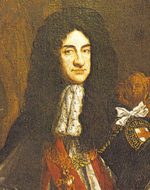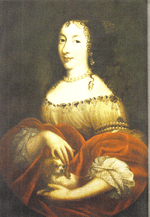Secret Treaty of Dover

The Treaty of Dover, also known as the Secret Treaty of Dover, was a treaty between England and France signed at Dover on 1 June[1] 1670. It required that Charles II of England would convert to the Roman Catholic Church and assist Louis XIV with 60 warships to help and 4000 soldiers in France's war of conquest against the Dutch Republic. In exchange, Charles would secretly receive a yearly pension of £230,000, as well as an extra sum of money when Charles informed the English people of his conversion, and France would send 6,000 French troops if there was ever a rebellion against Charles in England. The secret treaty was signed by Arlington, Arundell, Clifford and Bellings for England and Colbert de Croissy for France. Both kings exchanged letters of ratification and kept secret the existence of the treaty,[2] A public treaty of Dover was also negotiated, but it was a fake designed for propaganda and to hide the religious dimension of the secret treaty. The Third Anglo-Dutch War was a direct consequence of this treaty.[3] The actual treaty was published by historians a century later.
Negotiation and provisions

Exactly who first proposed the alliance between the two kingdoms is unknown, as is the date when the possibility was first discussed. However, the two nations had secretly discussed forming a closer relationship since 1663. The only participants in the talks to begin with were Louis XIV of France, Charles II of England, and Charles's sister Henrietta, duchesse d'Orléans. Louis was first cousin to Charles (through their grandfather Henry IV of France). Henrietta was also Louis's sister-in-law through her marriage to his only brother Phillippe, duc d'Orléans.[5]
By the secret treaty Charles was to abandon England's Triple Alliance with Sweden and the Dutch Republic in favour of assisting Louis in conquering the Dutch Republic. Provided that the conquest was successfully completed, England was promised several very profitable ports along one of the major rivers that run through the Dutch Republic.[6] The main components of the treaty can be paraphrased:
The King of England will make a public profession of the Catholic faith, and will receive the sum of two millions of crowns, to aid him in this project, from the Most Christian King, in the course of the next six months. The date of this declaration is left absolutely to his own pleasure. The King of France will faithfully observe the Treaty of Aix-la-Chapelle, as regards Spain, and the King of England will maintain the Treaty of the Triple Alliance in a similar manner. If new rights to the Spanish monarchy revert to the King of France, the King of England will aid him in maintaining these rights. The two Kings will declare war against the United Provinces. The King of France will attack them by land, and will receive the help of 6000 men from England. The King of England will send 50 men-of-war to sea, and the King of France 30; the combined fleets will be under the Duke of York's command. His Britannic Majesty will be content to receive Walcheren, the mouth of the Scheldt, and the isle of Cadzand, as his share of the conquered provinces. Separate articles will provide for the interests of the Prince of Orange. The Treaty of Commerce, which has already begun, shall be concluded as promptly as possible.[7]
The secret treaty did not in fact become public until 1771 after the historian Sir John Dalrymple published its contents in his Memoirs of Great Britain and Ireland.[8] Had it been published in Charles II's lifetime, the results might have been drastic; considering the enormous effect of Titus Oates' highly unreliable assertions of a Popish Plot, an even greater backlash might have followed had the English public learned that the King actually obliged himself to turn Catholic and that he was willing to rely on French troops to impose that conversion on his own subjects.
The "cover" treaty
The secret treaty was signed and sealed in June 1670. The Duke of Buckingham was then appointed to negotiate a treaty with the King of France. He was amazed by how smoothly it went. This treaty closely followed the secret treaty just concluded, but the clause by which King Charles was to declare himself a Roman Catholic as soon as the affairs of his kingdom permitted did not appear; neither, therefore, did the stipulation that the attack on the Netherlands would follow his declaration. This treaty was signed by all five members of the Cabal Ministry on 21 December 1670 and was made known to the public. However King Charles and the French knew it was a meaningless fake.[9][10][11]
Consequences
Military preparations took some time. Louis declared war on the Dutch on 6 April 1672, and Charles followed suit the next day. The Third Anglo-Dutch War failed to go off as originally planned. The costs of deploying the English fleet were much greater than expected, and the money sent by Louis to offset the costs did not come close to enough. Furthermore, the Dutch, led by Captain-General William of Orange put up a much better fight than expected. Desperate for funds, Charles was forced to call Parliament into session for the first time in over two years. He had hoped to keep it prorogued in order to wage the war without its oversight. In 1674, largely because of pressure put upon Charles by Parliament, England signed the Treaty of Westminster ending their involvement in the third Anglo-Dutch War. The French would continue to fight for four more years before signing the Treaty of Nijmegen.
In 1672, Charles issued a Declaration of Indulgence which suspended the penal laws against nonconforming Protestants and also relaxed (but did not suspend) the penal laws applying to Roman Catholics. When Parliament reconvened that year, they denounced the Declaration and announced that the English monarch did not possess the power to issue proclamations that suspended penal laws passed by the Parliament. Furthermore, they refused to fund the ongoing Third Anglo-Dutch War until the declaration was withdrawn. Charles was forced to comply with Parliament's demands, thereby ending the chance offered by the treaty of reconciling England with the Roman Catholic Church.[12]
The treaty's reference to the possibility of "new rights to the Spanish monarchy reverting to the King of France" envisaged the possibility of the Spanish King Charles dying childless, and of Louis then claiming the Spanish throne for the House of Bourbon. At the time of the treaty, the Spanish monarch was only nine years old, but his infirmity was already evident and well-known, casting doubt on his ever being able to beget children. However, by the time when it did happen - the King of Spain indeed dying childless in 1700 - the orientation of British foreign policy had completely reversed. Far from the King of England aiding the French one in "maintaining his Spanish rights", Britain went to a major war - the War of Spanish Succession - in order to block these French ambitions.
See also
References
- ↑ Madame, a Life of Henrietta, Daughter of Charles I and Duchess of Orleans by J. Cartwright, Seeley and Co. Ltd., London, 1894, p. 332
- ↑ G.M.D. Howat, Stuart and Cromwellian Foreign Policy (1974) pp 126–32.
- ↑ Ronald Hutton, "The Making of the Secret Treaty of Dover, 1668–1670." Historical Journal 29.2 (1986): 297-318. online
- ↑ Coote, Stephen (2000), Royal Survivor: The Life of Charles II, ISBN 0-312-22687-X .
- ↑ David Ogg, England in the Reign of Charles II (2nd ed. 1936) vol 1 p 342-44.
- ↑ Ogg, England in the Reign of Charles II vol 1 pp 344-46.
- ↑ Andrew Browning, ed. English Historical Documents: 1660-1714 (Eyre & Spottiswoode, 1953), pp 863-67 for text; paraphrase by François Mignet from Julia Ady, Madame (1894) pp. 332–33.
- ↑ J. P. Kenyon, The History Men. The Historical Profession in England since the Renaissance. Second Edition (Weidenfeld and Nicolson, 1993), pp. 67-68.
- ↑ Antonia Fraser, Royal Charles: Charles II and the Restoration (1979), pp. 275–276
- ↑ Ogg, England in the Reign of Charles II vol 1 pp 346-48.
- ↑ Tim Harris, Restoration: Charles II and his kingdoms, 1660-1685 (2006) p 71.
- ↑ Ogg, England in the Reign of Charles II vol 1 pp 354-55, 365-68.
Bibliography
- Ady, Julia (1894), Madame, a Life of Henrietta, Daughter of Charles I and Duchess of Orleans, London: Seeley & Co, pp. 332–33 .
- Black, Jeremy. "British Foreign Policy and International Affairs during Sir William Trumbull's Career." The British Library Journal 19.2 (1993): 199-217.
- Browning, Andrew, ed. English historical documents: 1660-1714 (Eyre & Spottiswoode, 1953), pp 863–67 for text.
- Bryant, Arthur. King Charles II (1955), pp. 154–68.
- Feiling, Keith. British Foreign Policy 1660-1672 (1930). excerpt 1968 reprint
- Howat, G.M.D. Stuart and Cromwellian Foreign Policy (1974) pp 95–138.
- Hutton, R (1986). "'The Making of the Secret Treaty of Dover, 1668–1670". The Historical Journal. 29 (2): 297–318. doi:10.1017/S0018246X00018756.
- Jones, J. R. Country and Court (1978), pp 64–73.
- Lodge, Richard. "English Foreign Policy, 1660–1715" History 15#60 (1931) pp 296–307.
- Maurice, D. Lee Jr (1961). "The Earl of Arlington and the Treaty of Dover". Journal of British Studies. 1 (1): 58–70. doi:10.1086/385435. JSTOR 175099.
- Miller, John. Popery and politics in England (Cambridge UP, 1973), pp. 108–14.
- Ogg, David. England in the Reign of Charles II (2nd ed. 2 vol 1936)